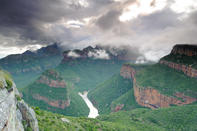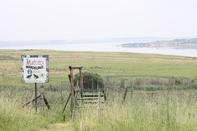Biggest Canyon in South Africa
Blyde River Canyon might be the biggest canyon in South Africa, but don't believe it when someone claims it's one of the biggest in the world. To set the record straight, it is not even among the 10 biggest, or 20, or even 30… but then even the Grand Canyon in the United States is not among the 10 largest (which are all in the Himalayas).

The best description for the Blyde River Canyon on the Mpumalanga Escarpment, is that it is the world's biggest ‘green canyon’ being covered in lush vegetation, while most of the others are either glacial valleys or desert canyons. But size does not always count: from its start at Bourke's Luck Potholes, through its forested labyrinths, to its maw beyond the Three Rondavels at Blydepoort, where the river forms a huge man-made lake, it is one massive and magnificent adventure just waiting for you to happen along.
Sudwala Caves

Sudwala Caves were at the top of a twisting road beside a dinosaur park where a life-size Allosaurus sank its teeth into a downed Brontosaurus, blood gushing everywhere.
“These pre-Cambrian caves are about 240 million years old and were formed when gigantic stresses cracked the dolomite,” explained my guide as we echoed past formations with names like Screaming Monster and Devil’s Workshop. “Rainwater percolated into the cracks carrying carbon dioxide and acidic ground matter, dissolving away the limestone in the rock and forming this subterranean dreamland.” The oldest formation, Samson’s Pillar, a thick stalactite, was wet, water carrying on its age-old action like some preternatural plant.
This dripping cave was a fitting spot to end my escarpment meander. I’d been travelling through a landscape created by water, shrouded by mist, pelted by rain. I’d explored tranquil dams, forded brooks that promised the twin riches of gold and trout, perched above lucky potholes and witnessed the anger of swollen falls. I’d ventured underground into chasms carved by water and decorated with pillars built from living droplets.
Warm and Sluggish Water

The Vaal River rises on the watery plateau near Chrissiesmeer in Mpumalanga but it never has the youthful energy of a mountain stream, or even that of a strongly flowing middle-sized river, as its entire course is run across the fairly even surface of the interior plateau, where it supplies most the water needs of the Pretoria-Witwatersrand-Vereeniging industrial complex. The warm and sluggish water encourages blooms of plankton which form the basis of food-chains in the old river.
Wild willow trees (Salix mucronata) and the larger, more common, but alien Salix babylonica are often the only trees that grow in the areas through which the Vaal River passes. They drop their leaves into the river, supplementing food-chains, and they provide important shade for animals and nesting for birds. Egrets and grey herons nest in the large willow trees that overhang the banks and frequent the shallows where they pluck fish from the water, crabs from the muddy bed and frogs, spiders or small reptiles from the banks.